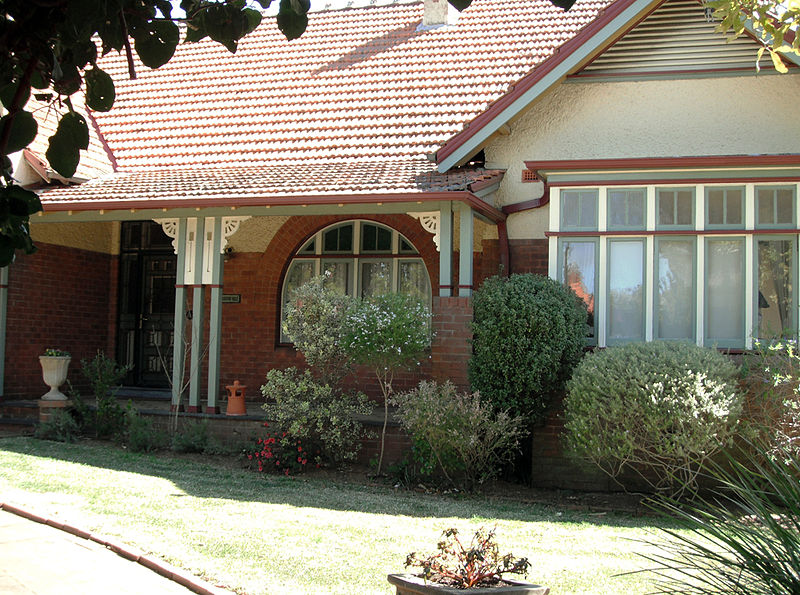Examples of Arts and Crafts style Houses in Australia
Table of Contents
- See also Federation Arts and Crafts
- See also Haberfield Arts & Crafts Style
The English Arts and Crafts movement had an influence on the architecture of Australia, from the late 1800s, where the style of building was adapted to the Australian landscape and conditions.
- As its name implies, the style was concerned with the integration of art into everyday life through the medium of craftsmanship.
- There is a strong flavour of morality, with stress on the truthful use of materials and the honest expression of function.
Koreelah, Byron Bay on 10 acres - Arts and Crafts buildings are unpretentious and informal, evoking an atmosphere of comfortable familiarity.
- In Australia, Federation Arts and Crafts architecture exhibits qualities similar to those of the overseas models from which it drew inspiration.
- Buildings in this style are domestic in scale and make free use of traditional (usually English) vernacular motifs to achieve an unassuming, homely, well-established character.
- Designers aimed for informality in planning, massing, fenestration and landscaping.
- The roof is a dominant element, featuring gables (with barges or parapets) and/or hips of medium to steep pitch and prominent eaves. Tall, tapering chimneys, battered wall- buttresses and bay windows are characteristic elements of the style.
- Pebbledash stucco (roughcast) was commonly used as an exterior wall finish, together with other materials having earthy, ‘natural’ colours and textures.

Amberwood Estate, central Randwick - Interiors frequently display timber panelling and sturdy ceiling beams. Touches of Art Nouveau detail are common, both externally and internally. -http://www.sydneyarchitecture.com/STYLES/STY-F11.htm
Amberwood, 10 Milford Street Randwick
- "Magnificent character home, ocean views"Auction: Monday 22nd October 2012 @ 6pm
"One of Randwick's most impressive character homes, 'Amberwood' is a grand 1920s residence set on a vast 1377sqm parcel of land just footsteps from Randwick Junction. Capturing sweeping ocean views from its elevated vantage point, this classic home is blessed with abundant entertaining space, grand proportions, lovely traditional features and further potential.
- "STEP through the once-gilt driveway gates of the Amberwood Estate and prepare for a trip down memory lane.
- "Such is the grandeur and quality build of this 1921 Federation home, it seems like time has stood still.
- "As the footpath curves around the house to the triple-panelled timber and glass front doors, you get the first glimpses of its fine features that include a leadlight bay window set in striking blue brick."

- The entry hall is a testament to superior craftmanship and bevelled glass doors on two sides disappear into the hardwood joinery to reveal two rooms equally as impressive as each other.

- To the right is the enormous formal lounge with timber-panelled walls and built-in cabinetry.
- A bay seat framed by leadlight windows looks out to a postcard view of the ocean.
- On the other side of the hall is a grand games room, big enough to house a full size billiards table.

- Beyond the front hall frosted french doors open and the hallway continues.
- A formal dining room with open fireplace connects to the east-facing sunroom set with original sandstone walls and picture windows looking to the ocean.
- Further living space is found on the upper level where the striking timber-vaulted ceiling looms high and features four skylights.
- A matching wooden bar is perfect for serving after dinner drinks and a quirky touch comes via the model railway track that disappears behind the wall.
- A built-in study is tucked into the corner and a private bedroom with claw bath ensuite is off this big room.

- In the rear garden a separate two-storey building with ocean views is unrenovated but can be configured to suit tastes.
- The home sits on a 1377sqm block and includes an established front garden and rockery.
- A home built as structurally sound as this requires only minor modification.

- 5 Bedrooms, 3.5 Bathrooms, 5 Parking
- Huge whole-floor master suite with study, WIR
- Grand lounge with gas fire, formal dining, sunroom

- Billiard room /home theatre, dine-in gas kitchen

- Partially completed guesthouse/office with views
- High ornate ceilings, leadlighting, timber panelling
- DLUG, driveway parking, sprawling grassed garden
Koreelah - Byron Bay
284 Skinners Shoot Road, Byron Bay NSW 2481, Australia$5 million-plus when expressions of interest close October 31, 2012

"Commercial property investors James Dawson and Anthony Pangallo are selling Koreelah, their five-bedroom 1905 Byron Bay hinterland farmhouse."
- It's an original Arts and Crafts-style house nestled on the hill below St Helena at Skinners Shoot.

- All its rooms home featuring mahogany and teak floors and rosewood detailed ceilings open onto verandas.

- The location was first settled in 1890, with the 1905 house trading for the only time in 1998 when bought from the original owners, the Raywards, one of Byron’s oldest families .

- It had a sympathetic renovation to make it all quite luxurious.




"A large stone fireplace is the central feature of a spacious open plan living area that overlooks the entertaining decks, the pizza oven and the pool. The kitchen is an entertainer’s delight with stainless steel benchtops, ample storage & a large oven. Bi-fold windows connect it to the deck and the views over the countryside will instantly relax.




- There's a pool in its two-hectare Skinners Shoot Road grounds.

- Its short stay rates are from $750 per night in the low season to $1,500 per night in the peak.



























 Haberfield Property Company. It is a fine single-storeyed brick residence designed in the Federation Queen Anne style of architecture. The facade brickwork is tuckpointed.
Haberfield Property Company. It is a fine single-storeyed brick residence designed in the Federation Queen Anne style of architecture. The facade brickwork is tuckpointed.





























